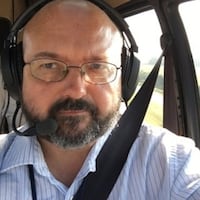No one was hurt, and the landing was not hard, said Don Adams, president of Wright “B” Flyer Inc., the organization that preserves a trio of aircraft and a Miami Twp. museum that pay homage to the early work of the Wright Brothers.
Now, the volunteers behind the organization are preparing to test recent repairs to the bi-plane’s engine and, they hope, take the plane up for the first time in months.
“We will start testing in the next week or so,” Adams said in an interview.
Credit: DaytonDailyNews
Dubbed the “White Bird,” the plane that was brought down last year is a “lookalike,” not an exact replica, of the Wright Brothers’ Model B, the plane produced at the first purpose-built airplane factory in the world, in West Dayton.
A drive chain slipped off its sprocket, said Adams, who is also mayor of Beavercreek. That caused the engine, which drives dual propellers, to rev beyond its limits.
“Once the chain came off, we lost power,” Adams said.
The two pilots on board allowed muscle memory honed by years of flying to take over, setting the plane down.
The engine was smoking and still dieseling on landing, but as far as Adams is concerned, it was arguably the best landing the White Bird has ever seen.
The pilots were able to radio their intentions to base air traffic controllers, who quickly called fire crews to respond.
“They were right there on the spot,” Adams said. “They did everything they could to help us.”
Volunteers identified several problem areas to address with the plane. They’re confident it will not only fly again, but fly better than ever.
“Chains have a tendency to loosen up a little bit,” Adams said. “They just got a little bit loose. When they (pilots) went to put the power on, because of the slacking, it popped off.”
A $75,000 grant from the National Heritage Aviation Area (NAHA) was crucial to making repairs happen. Adams and Jim Papa, chair of the Wright “B” Flyer board of trustees, expressed gratitude to NAHA, which preserves and presents aviation-related sites within a federally designated national heritage area in and around Dayton.
“That’s probably the reason we were able to rebuild the aircraft,” Adams said, referring to the grant. “I’m really happy that we had that relationship with NAHA.”
“It’s been a long journey,” said Papa, retired engineering and technical management director for Air Force Materiel Command, which is headquartered at Wright-Patterson.
Early iterations of the Wright Model B were sold to the Navy and the U.S. Signal Corps. On the ground, knowledgeable observers will see serious updates to the plane, but when it’s a few hundred feet above the ground, it looks very close to something Wilbur and Orville Wright might have piloted in 1910.
“Their main contribution, of course, was being able to control a vehicle that’s flying,” Papa said. “Other attempts were not very successful in doing that.”
Added Adams, “That was all done here in Huffman Prairie,” referring the northwestern Greene County field now part of Wright-Patterson.
About the Author



